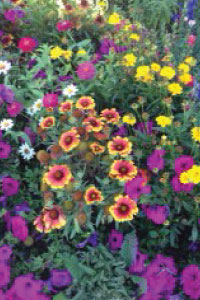Wildflowers
 Create Beautiful Landscapes with Wildflower Mixtures
Create Beautiful Landscapes with Wildflower Mixtures
The interest in establishing flowering fields comprised of wild flowers and flowering herbs has grown in recent years. It is important to understand that a flowering field will not usually grow well on its own accord. It requires careful cultivation. If the proper steps are taken establishing a flowering field and certain maintenance is done, a wildflower field will truly blossom.
Establishing New Flowering Fields
When establishing a flowering field in cultivated soil, such as former agricultural soil, problems may arise due to excessive nutrients in the soil and/or a large a quantity of existing weeds. It may be necessary to combat these weeds with chemicals, or possibly allow existing plants to wither, and then remove the dead material. It is important not to add nutrients to the soil during the conversion process. In general, soil that is low in nutrients will provide the best conditions for a flowering field. The soil can then be plowed and harrowed, or turned with the help of a rotary cultivator, to create a suitable bed for planting. Alternatively, the soil can be allowed to remain fallow over the summer, i.e. to repeat harrowing and allow as many weed seeds to sprout as possible.
Flowering Fields in Existing Grass Covered Areas
Establishing a flowering field in an existing area covered by grass quite challenging. If the existing grass is fairly dense and well fertilized, it may be almost impossible. The established grass will out grow sprouting wild flowers. If the existing grass is more spread out, the chances of success are better. For the best results follow these simple procedures:
-
Using an herbicide, spray out existing plants in the area to be planted into wild flowers. Do this during late summer one or two times as necessary to eliminate undesirable plants.
-
Remove the dead plant material
-
Seed during the the fall of that same year
The herbs will begin to sprout during the following spring – naturally dominated by the annuals during the first year. For those who do not wish to use chemicals prior to planting, it may be necessary to remove entire sections of sod in order to elimate undesirable plant material. In this case, a certain number of unwanted species are sure to germinate and must be expected.
Seeding
The best time to seed a permanent flowering field is the fall. This fits well with the natural seed dissemination of the herbs. Many species will sprout during the spring, after the cold of winter has broken the dormancy of the seeds and allowed germination to begin. Other species will sprout immediately and face the winter as small plants.
The method of seeding depends on the size of the area. Hand seeding can be used in small areas; possibly with the addition of filler material such as sand to distribute the seeds evenly. A mechanical seeder is recommended for larger areas and will provide the most uniform distribution. The best solution is to use a special seeder designed for lawn grasses. For most species, seeding depth should not exceed 1/4 inch.
Caring for Flowering Fields
In general, flowering fields should only be mowed once a year during the late summer, after the main flowering period. Mowing should be carried out with a rotary or flail mower, and the cut material should be removed from the area. Fields of flowers should not be fertilized. If large quantities of unwanted plants appear during the first year, it may be necessary to mow the field twice, mowing for the first time before the unwanted species spread their seeds.
Wildflowers from DLF
The wildflower mixtures offered by DLF consist of approximately 20 different wild flowers that differ in color and growth. It is a mix of annual and perennial types. Some of the species are:
-
Amaranthus retroflexus
-
Echium vulgare
-
Marrubium vulgare
-
Salvia nemorosa
-
Tanacetum vulgare
-
Centaurea cyanus blue
-
Verbascum phlomoides
-
Papaver rhoeas
The species vary from year to year according to availability, but will always show the very best diversity and are suited for use on most types of soils. Low mowing and non-aggressive grasses such as sheep fescue and hard fescue may be included in wildflower mixes when desired:
Quantity of Seeding Mixture: 1 to 2 lbs per 1,000 sq. ft.*
Seeding time: Late Summer/Fall
*Add more seed according to the density desired.
